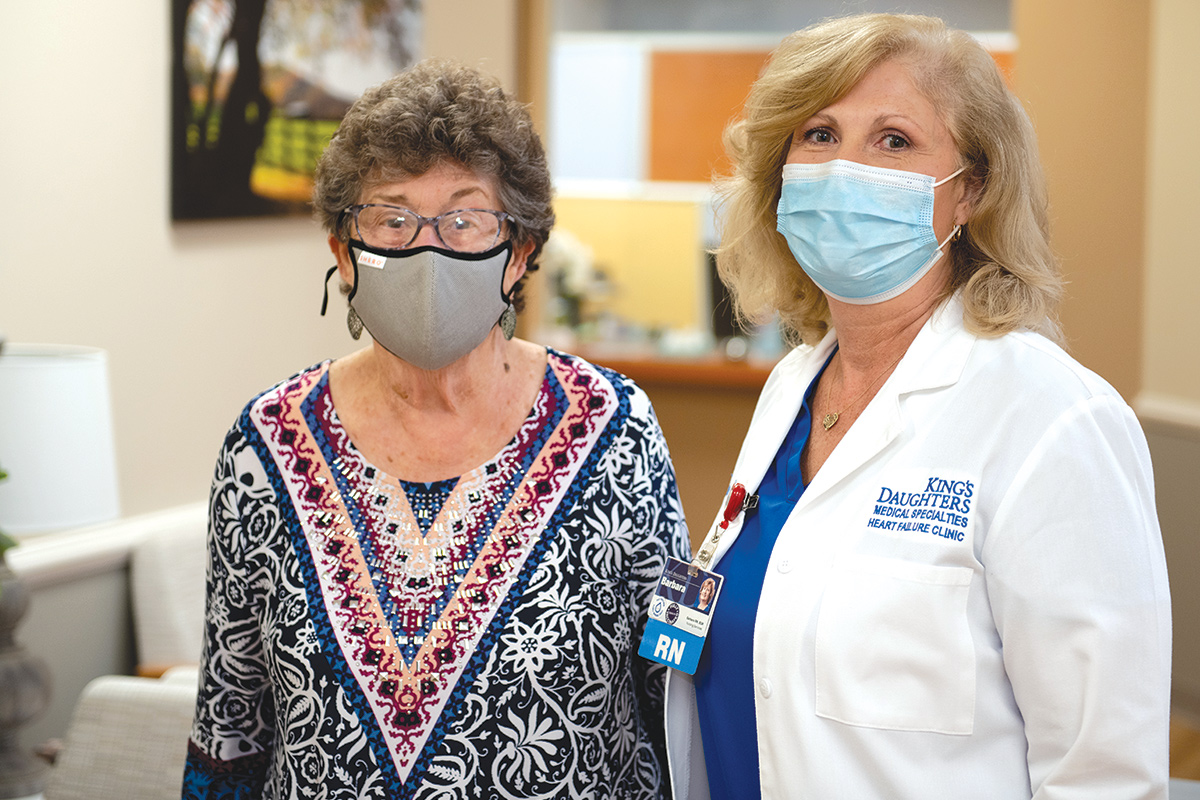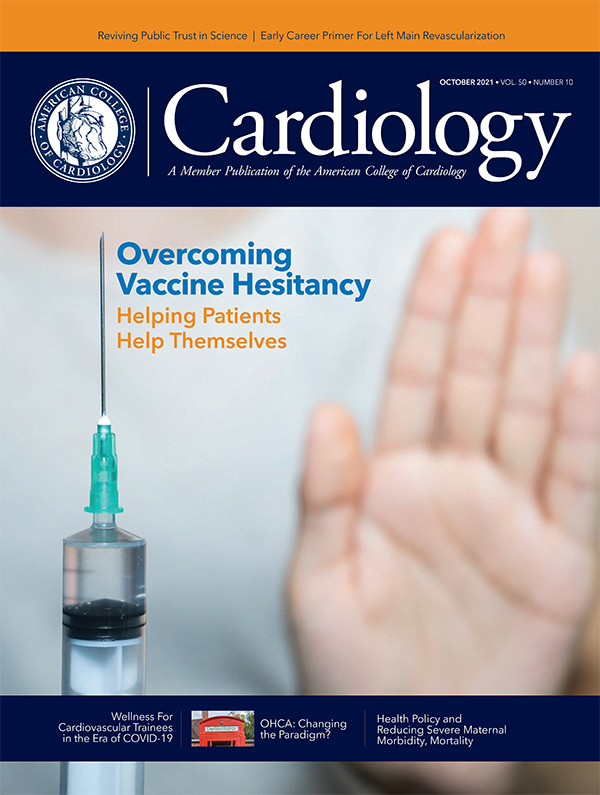Focus on Heart Failure | Remote Monitoring in CHF: Staying #Healthy@Home
 Ms. Buck and Ms. Davis
Ms. Buck and Ms. Davis
The optimal treatment and management of congestive heart failure (HF) is an area in cardiology that continues to be elusive. The more we learn, it seems the less we know. After decades of prescribing relatively static HF regimens with a beta-blocker and renin-angiotensin-aldosterone antagonist backbone, the past decade has witnessed an explosion of trials demonstrating the incremental benefit of novel pharmacotherapeutics. We have welcomed several new tools to the pharmacologic armamentarium that have now become integral to our practice: the If channel blocker (ivabradine), angiotensin-receptor neprilysin inhibitors (ARNIs, like valsartan/sacubitril), SGLT2 inhibitors (dapagliflozin, empagliflozin, etc.), and soluble guanylate cyclase (sGC) stimulators (vericiguat).
Despite these advances and the growing number of pharmacological options, treating patients with HF remains extremely challenging and burdensome to all parties. Morbidity and mortality remain a major burden to patients, caregivers and national health care systems.1 The toll is substantial, with a 10% mortality rate at 30 days after hospital discharge,2 50% rate of readmission for HF at six months,3,4 and the risk of mortality increases with each hospitalization.5 There is a remarkable one-year mortality rate of approximately 20% in patients who have been hospitalized for HF.6 In sheer dollar terms, the cost of treating HF is staggering, at an estimated $30.7 billion in 2012, including medications, health care services and missed days of work.7 By 2030, it's projected the total cost of HF will hit $70 billion.
Key to the management of HF are frequent clinical assessments of evolving symptoms and changes on physical examination as well as titration of guideline-directed medical therapy, which are essential to mitigate progression and decompensation of HF. However, the COVID-19 public health emergency, with stay-at-home orders and physical distancing, has made this standard approach challenging.
This challenge, though, has led to new opportunities as health care systems have rapidly deployed and refined a new model of care: the virtual visit. These virtual visits have increased the reliance on remote monitoring which had not been in widespread use previously.
Benefits of Remote Monitoring
Remote monitoring of intracardiac and pulmonary artery pressures can provide clinicians with access to actionable pathophysiological information, and help improve the serial decision-making process necessary to prevent HF hospitalizations and improve other clinical outcomes.8 This is largely because studies have demonstrated that increases in cardiac filling pressures can often be detected several weeks before patients experience symptoms of acute decompensated HF that require hospitalization, providing clinicians with a therapeutic window of time for effective intervention.9
Recent technological advances have allowed increasingly sophisticated attempts to remotely monitor and manage the HF syndrome. These advances range from simple, telephone-call based, remote assessment by a HF nurse specialist with the aid of a weight scale and blood pressure cuff to standalone home-based systems to implanted devices (such as cardiac resynchronization therapy and implantable cardiopulmonary sensors) to wearable technologies that have opened up a world of possibilities.
Collecting data remotely has not been difficult. The challenges are integrating such potentially continuous data streams into systems of care and then to convert more data into better decision-making that improves the outcome or experience of care.
As the director of a HF program in rural America, I can attest to the struggles that clinicians in a rural, geographically sprawling catchment area of more than 100 miles in all directions encounter when treating patients with complex, multidisciplinary problems such as HF. Uniquely, in my geographic area, there is also a paucity of internet and cellular telephone access, further adding to the challenge of utilizing remote monitoring strategies that would serve our patients.
Given the struggles we face with this patient population and the difficulty of seeing all patients in the office, our program has opted to pursue a strategy of remote monitoring utilizing the CardioMEMS implantable pulmonary artery sensor, the only one approved by the U.S. Food and Drug Administration.
Since our first implant of a CardioMEMS device at King's Daughters Medical Center (KDMC) in 2016, we have widely expanded its use to help manage patients who have had repeated readmissions for HF with great success. KDMC now monitors more than 125 patients with the CardioMEMS device.
Recently I visited with a provider and a patient on the front line in the fight against HF. Barbara Davis, BSN, RN, is the lead nurse of the KDMC HF Clinic and she is responsible for managing our CardioMEMS patients. Janet Bliss Buck recently celebrated her 85th birthday and spoke with us by phone from her home in rural Kentucky. We talked about living with and treating HF and their experiences with the CardioMEMS device.
Krishnan: What are some of the challenges our patients face living in a rural area compared to an urban area?
Davis: Although I grew up in Appalachia, because I lived in Houston, TX, for several years I have an understanding of both lifestyles. One of the most unique aspects of living in Appalachia is the large extended family units that are tight knit and able to provide support to most patients. However, living in a remote area means our patients often live more than an hour away from the closest health center. There's also a significant socioeconomic bridge to get the things they need. This area has had a real downturn in the economy, which started well before the pandemic. Many of our younger patients have lost their jobs in the steel mills and railroad yards and the shift to cleaner fuel has led to a decline in Ashland Oil. Then we also lost the only other hospital system in the neighboring county which has also put our resources under more strain. The lack of medical literacy and the lack of phone/internet access compounds these challenges.
We have a tremendous number of patients with whom we'd like to have telehealth visits, but they do not own a cell phone and they do not have cellular or internet service that is sufficient for a video visit. We also have some patients who have difficulty transmitting CardioMEMS readings to our clinic through landlines.
Krishnan: From a provider's perspective, how does living in a rural area compare to an urban area?
Davis: If the patient does not have financial means or transportation, the patient is unable to do the necessary follow-up which then makes the visit less useful. We do everything in our power to help patients get remote assistance. One of our clinic nurses, just last week, drove to a gas station near a patient's home to obtain the patent's signature on the paperwork for the patient assistance program. Even if we're able to obtain a reduction in the patient's co-pay, say from $500/month to $40/month, this still may not be affordable and may mean the patient is not able to afford their other medications because many are on fixed incomes.
Krishnan: How has your approach to remote monitoring changed during your career?
Davis: When I first started my nursing career in 2005 remote monitoring and telehealth were not part of the vernacular.
However, within a few years we started using a program called TeleHealth Monitoring System that was placed in the home and consisted of a weight scale, blood pressure monitor and a pulse oximetry machine. This was hooked up to a landline and the information came into a secure website. I would even check this on weekends. If patients had a gain in weight >3 lbs, I'd call them to assess symptoms. This was our approach to keep patients out of the hospital. We used this system for two to three years and it worked perfectly for patients who were adherent in sending information to the clinic, but it was worthless for patients who did not engage with the system.
We paid dearly for installing each system and when there was a downturn in our local economy resulting in widespread layoffs, the TeleHealth system was one of the first casualties as it was deemed to be cost prohibitive. After this, we kept a list of patients who we touched base with frequently and did 1:1 phone visits with patients who did not have much family support. And we did the same for patients who were frequent visitors to the emergency department. We also started HF support groups which were well attended by patients and families.
Now we are monitoring patients using the CardioMEMS device and the program continues to grow.
Krishnan: Have you seen success with the CardioMEMS program?
Davis: Yes. We have patients who had multiple admissions pre-implant who have since been able to stay out of the hospital. When we call patients with concerns about increased pressure based on the remote monitoring, they are totally amazed because then they recognize they had some increase in weight. Overall, we have seen a reduction in readmission in patients who have been implanted with the device.
Krishnan: Ms. Buck, please tell me a little bit about your HF journey. When and how were you diagnosed?
Buck: I was in the hospital a few years ago and I had two heart caths. They both turned out okay, but then I had fluid that was gathering and my feet were swelling so bad. I have stage 4 kidney disease and my kidney doctor has had me on Lasix for years, but still I had swelling so bad that I was referred to the congestive heart failure clinic and that's when I found out I had HF.
Krishnan: What has been your experience with CardioMEMS?
Buck: It was implanted on the day after Christmas in 2017. I was the seventh patient at King's Daughters to get one. At first, I didn't understand what it was or where it was placed. Then I spoke with the technician who helped me set it up and explained it to me and it makes a lot of sense. I do the readings every day, by just laying on a pillow that talks to me and tells me not to move. It takes just a few minutes and the information goes to the HF clinic and I think it goes to my kidney doctor's office too.
This monitoring is helpful because it lets me know if I am having too much fluid and gives me an early warning sign that I need to change my diet. It also allows the HF clinic to keep in touch with me and that makes me feel secure. Before I got this, I did not keep up with my weight or blood pressure. Doctors were just kind of guessing about how much fluid I took in. Plus, because I live almost 45 minutes away from the HF clinic it is difficult for me to get there.
Krishnan: What is the hardest thing about having heart failure?
Buck: Oh, it's the fluid, I think. Being limited on how much fluid I can have is very difficult especially during the hot Kentucky summer. I'm hoping this monitoring is keeping me on track and that I won't have a heart attack or a stroke.

This article was authored by Sandeep Krishnan, MD, RPVI, FACC, an interventional and structural cardiologist at the King's Daughters Medical Center in Ashland, KY.
References
- Roger VL, Weston SA, Redfield MM, et al. Trends in heart failure incidence and survival in a community-based population. JAMA 2004;292:344-50.
- Loehr LR, Rosamond WD, Chang PP, et al. Heart failure incidence and survival (from the Atherosclerosis Risk in Communities study). Am J Cardiol 2008;101:1016-22.
- Hunt SA, Abraham WT, Chin MH, et al. 2009 Focused update incorporated into the ACC/AHA 2005 Guidelines for the diagnosis and management of heart failure in adults. J Am Coll Cardiol 2009;53:e1-e90.
- Maggioni AP, Dahlstrom U, Filippatos G, et al. EURObservational Research Programme: regional differences and 1-year follow-up results of the heart failure pilot survey (ESC-HF Pilot). Eur J Heart Fail 2013;15:808-17.
- Solomon SD, Dobson J, Pocock S, et al. Influence of nonfatal hospitalization for heart failure on subsequent mortality in patients with chronic heart failure. Circulation 2007;116:1482-7.
- Lam CSP, Chandramouli C, Ahooja V, Verma S. et al. SGLT-2 inhibitors in heart failure: current management, unmet needs, and therapeutic prospects. J Am Heart Assoc 2019;8:e013389.
- Virani SS, Alonso A, Benjamin EJ, et al. Heart disease and stroke statistics 2020 update: A report From the American Heart Association. Circulation 2020;140:e139-e596
- Adamson PB, Magalski A, Braunschweig F, et al. Ongoing right ventricular hemodynamics in heart failure: Clinical value of measurements derived from an implantable monitoring system. J Am Coll Cardiol 2003;41:565-71.
- Abraham WT, Adamson PB, Hasan A, et al. Safety and accuracy of a wireless pulmonary artery pressure monitoring system in patients with heart failure. Am Heart J 2011;161:558-66.
Clinical Topics: Arrhythmias and Clinical EP, Cardiovascular Care Team, COVID-19 Hub, Dyslipidemia, Heart Failure and Cardiomyopathies, Prevention, Implantable Devices, Lipid Metabolism, Novel Agents, Statins, Acute Heart Failure, Heart Failure and Cardiac Biomarkers, Diet
Keywords: ACC Publications, Cardiology Magazine, Aldosterone, Ambulatory Care Facilities, Angiotensins, Blood Pressure, Blood Pressure Monitors, Cardiac Resynchronization Therapy, Cardiologists, Cardiology, Caregivers, Cell Phone, COVID-19, Decision Making, Delivery of Health Care, Diet, Emergency Service, Hospital, Family, Follow-Up Studies, Furosemide, Heart Failure, Hospitalization, Hospitals, Internet, Internet Access, Ivabradine, Kentucky, Kidney, Kidney Diseases, Life Style, Morbidity, Myocardial Infarction, Neprilysin, Nuclear Family, Oximetry, Pandemics, Patient Discharge, Patient Readmission, Physical Distancing, Public Health, Pulmonary Artery, Railroads, Receptors, Angiotensin, Reference Standards, Renin, Self-Help Groups, Socioeconomic Factors, Sodium-Glucose Transporter 2 Inhibitors, Soluble Guanylyl Cyclase, Steel, Stroke, Telemedicine, Telephone, United States Food and Drug Administration, Valsartan, Wearable Electronic Devices
< Back to Listings

